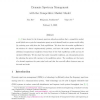Free Online Productivity Tools
i2Speak
i2Symbol
i2OCR
iTex2Img
iWeb2Print
iWeb2Shot
i2Type
iPdf2Split
iPdf2Merge
i2Bopomofo
i2Arabic
i2Style
i2Image
i2PDF
iLatex2Rtf
Sci2ools
TSP
2010
2010
Dynamic spectrum management with the competitive market model
[1, 2] have shown for the dynamic spectrum allocation problem that a competitive market model (which sets a price for transmission power on each channel) leads to a greater social utility (by reducing cross talk) than the Nash equilibrium. We show that the market equilibrium is the solution of a linear complementarily problem, and hence the market model possesses no additional computational complexity beyond that of the Nash equilibrium model and can be calculated efficiently. We also show that under reasonable conditions, any t^atonnement process for adjusting the prices will converge to the equilibrium prices. The conditions are that users of a channel experience the same noise levels and that the cross-talk effects between users are low-rank and weak.
Related Content
| Added | 22 May 2011 |
| Updated | 22 May 2011 |
| Type | Journal |
| Year | 2010 |
| Where | TSP |
| Authors | Yao Xie, Benjamin Armbruster, Yinyu Ye |
Comments (0)

